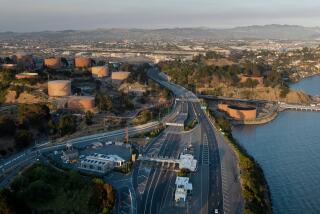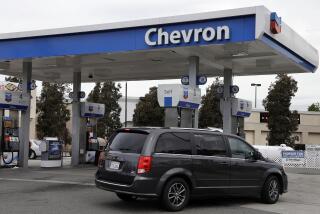Advances Let Oil Firms Go Where No Drill Has Gone Before
- Share via
Not so many years ago, petroleum industry experts described the Gulf of Mexico as the “Dead Sea,” a place whose oil fields close to shore were nearly tapped out. What petroleum was left lay too far offshore in depths too forbidding to make drilling worthwhile, or so they thought.
But big technological strides in oil exploration and development have made the gulf a scene of feverish exploration activity once more, fueled by billions of dollars in new investment by Chevron, Shell, British Petroleum and other oil companies.
And most of the activity is taking place far offshore, as far down as 2,600 feet below the surface--depths long considered inaccessible or too expensive to access.
The optimism has prompted a maritime version of the Oklahoma land rush: The semiannual bidding for drilling rights in the gulf reached record levels the last two years. About 2,404 tracts were leased in 1995 and ‘96, 2 1/2 times the number auctioned off in the previous two years.
Last week, the federal government released a study projecting that gulf oil production could reach 1.9 million barrels of crude per day by 2000--more than double the 1995 rate. And production of natural gas could increase 25% in the same period, according to the federal Minerals Management Service, which is in charge of offshore leasing.
“Deep-water gulf activity is the most exciting thing in the oil industry right now, along with the North Sea and the Caspian region of Russia,” said Todd Bergman, oil analyst at Goldman, Sachs & Co. in New York. “It’s truly a big thing.”
The technology that is opening up the gulf is typified by Chevron’s Genesis Spar oil platform, a giant floating steel cylinder two football fields long that seems straight out of a Jules Verne novel. Topped by a drilling and processing platform, Genesis Spar will float 2,600 feet above Chevron’s ocean-floor wells once it is installed next year.
The 700-foot cylinder’s design is so resistant to the heave and pitch of the gulf--even in 30-foot seas--that oil drilling and processing can be accomplished under conditions roughly equivalent to those on dry land. Chevron’s will be the second spar platform in the gulf: The first was installed by Oryx, the re-christened Sun Oil Co., in September.
Chevron will position the platform above an oil deposit that it found with the help of 3-D seismic imaging, a rapidly improving computerized method of analyzing seismic signals for what they say about oil deposits. The improved technology has helped geologists better penetrate the salt layers on the ocean floor, which tend to garble the echoes from seismic explosions that give geologic clues.
“We have new processing methods that compensate for the smearing that happens,” said David M. Clementz, president of Chevron Petroleum Technology of Houston, resulting in much more accurate geologic data and higher drilling success rates. “We have made discoveries under salt domes that, frankly, other people didn’t see.”
Innovations such as Genesis Spar, combined with improved seismic and drilling techniques, are letting companies drill farther out and deeper down with more confidence of hitting oil. There are now 40 confirmed “deep-water” discoveries in the gulf, meaning depths of more than 1,000 feet, up from only two in 1991. Eleven are already producing oil.
To be sure, technology is not the only thing spurring the boom.
The feverish activity also owes a lot to strong world prices for crude oil and to the U.S. Deepwater Royalty Relief Act of 1996, which reduced the government’s take of oil companies’ revenues from offshore finds. That makes it easier for offshore drilling companies to make a profit and to justify the multibillion-dollar risks of deep sea exploration.
The rejuvenation of gulf exploration is also due to the fact that it is “about the only place left in the country where you can develop oil to any extent” in the face of environmental restrictions, said John L. Kennedy, editor of Oil & Gas Journal, a Houston-based trade weekly.
But the leading role in the gulf’s resurgence has been played by technology. It has enabled oil explorers to, first, pinpoint likely deposits of petroleum and, second, to efficiently drill undersea wells to extract it. Much of the technology is evolutionary, but some--like the Genesis Spar--represents a bold leap forward.
The Genesis Spar incorporates 1987 design patents only now being brought into use, said Bob Harrell, president of Spars International, the Houston-based company that is making the platform for Chevron.
“It took that long to convince the oil industry that the technology would work,” Harrell said.
The Genesis Spar will have enough buoyancy to support the oil platform sitting atop it, while providing enough tension to prop up 16 oil “risers” measuring 12 inches in diameter used to transport oil and gas to the surface from the ocean floor 2,600 feet below. The cylinder is being built in Finland and will be towed across the Atlantic to the gulf in May 1998.
The spar is a radical departure from the mainstream deep-sea platform technology typified by so-called tension-leg platforms used by Shell, the acknowledged leader in gulf oil development.
Shell, which claims nearly half of all deep-water oil production in the gulf, became the pioneer when it installed the $1.2-billion Auger tension-leg platform in 1994 at 2,850 feet, then the deepest-water floating platform in the world. Tension-leg platforms are buoyant hulls fixed to the ocean floor with 12 lengths of 26-inch-diameter steel pipe “tendons.”
The success of Auger showed the industry not only that such drilling could be done, but that it could be immensely productive. At 75,000 barrels of oil and 165 million cubic feet of natural gas of average daily production, Augur’s eight wells produce more petroleum than the entire nation of Chile.
“Back in 1991, we would have believed that a successful well would produce 2,000 to 3,000 barrels a day. But we currently have them producing between 10,000 and 20,000 barrels per day,” said Rich A. Pattarozzi, president of Shell Deepwater Development, Shell’s New Orleans-based offshore exploration and production unit. “Once we started talking about the productivity of Auger, the industry took notice,” Pattarozzi said.
Last July, Shell, which operates five of the gulf’s 11 producing deep-water wells, set another milestone when it installed its second mammoth tension-leg platform, named Mars, in 3,000-foot waters southeast of New Orleans. A third will be installed this year, and a fourth, called Ursa, will be put in 4,000-foot waters in 1998, setting yet another record.
“Shell will be growing at 15% a year or so. They stand out like night and day,” analyst Bergman said.
Other companies want badly to emulate Shell’s success, and Chevron sees Genesis Spar, which it will put in place in the summer of 1998 about 150 miles south of New Orleans, as its ticket to the gulf’s big leagues.
“Once Shell made it known they had more oil than they knew what to do with, that told the industry that there was a whole oil province out there in deep water with the same characteristics” as the rapidly depleting oil fields closer to shore, Chevron’s Clementz said.
(BEGIN TEXT OF INFOBOX / INFOGRAPHIC)
Deeper Perspective
Chevron’s Genesis Spar floating oil production platform, a vertical, 700-foot-tall cylinder, is an example of the deep-water production technology that has enabled Chevron, Shell and other companies to tap sources of oil once beyond their grasp, especially in the Gulf of Mexico. In the past, oil more than 1,000 feet below the ocean’s surface was hard to find and too expensive to draw out. Equipment like the Spar--to be installed in 2,600-foot-deep waters 150 miles south of New Orleans next year--are extending the life of the oil age.
The Spar’s design and technology enable oil companies to work with a “dry wellhead”: They can access the oil from the spar’s platform, instead of on the ocean floor. Before, oil and gas were piped directly from the ocean floor to shallow-water or dry land processing facilities. Maintenance of such “wet wellheads” cost hundreds of thousands of dollars daily.
A. The spar is a floating steel cylinder that sits vertically in the water. Its design gives it unusual stability to resist ocean heaving and pitching.
B. The drilling and production platform is where oil and gas are brought to the surface and separated from water and mud before transportation and refining. The platform also accommodates a drilling rig.
C. Oil and gas from as many as 16 separate wells come to the surface through pipes, or “risers,” measuring about 12 inches in diameter, from depths of 2,600 feet. The processed oil and gas then go back down the pipeline to the ocean floor for transport.
D. Processed oil and natural gas are then shipped by pipeline up to 200 miles to dry land or shallow water refining facilities.
E. Fourteen mooring lines made of steel chain and cable tether the spar to the ocean floor.
More to Read
Sign up for Essential California
The most important California stories and recommendations in your inbox every morning.
You may occasionally receive promotional content from the Los Angeles Times.













